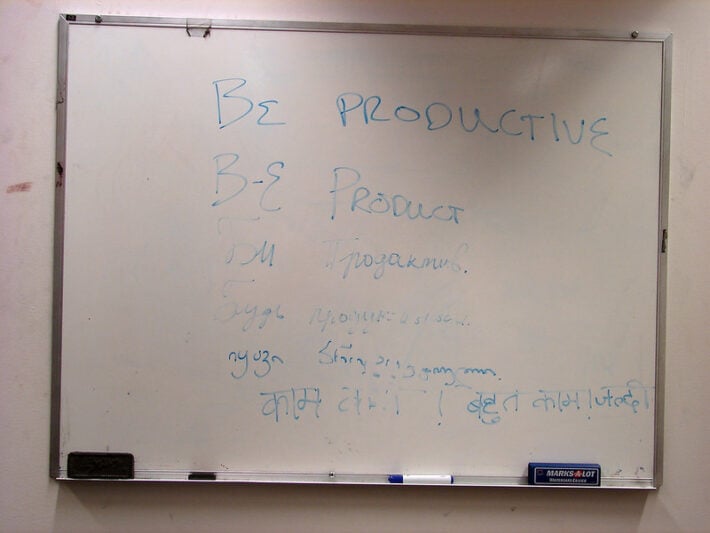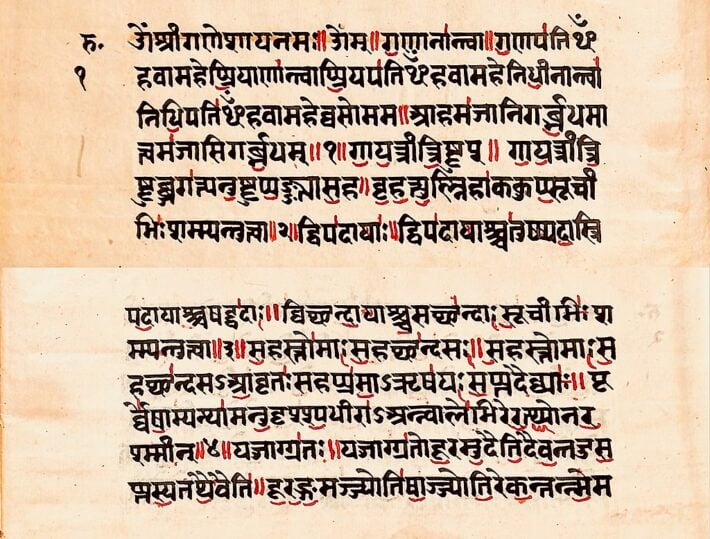The Hindi Alphabet Guide That’ll Make You Finally Get Hindi
Everyone who wants to learn a language that has a different alphabet will need three things: patience, practice and a good plan.
If you want to learn Hindi, for example, trying to memorise all 48 letters in one day is a big mistake and might end up with you throwing things across the room.
Now, how difficult is it to learn the Hindi alphabet?
We’re happy to say that it’s not difficult at all.
How many letters are there in the Hindi alphabet? The Hindi alphabet has 48 characters — 36 consonants and 12 vowels, and it’s written from left to right, just like English. But unlike English, which uses a Roman script, Hindi is written in a script called Devanagari. The good news is that, although the Hindi alphabet looks alien to English speakers, its 48 letters have sounds that are perfectly familiar and, in fact, have one-to-one equivalents in our language.

Table of Contents
The phrase “Be productive” in 6 languages, including Hindi, via Flickr
Learn Hindi with a qualified native speaker in your city or online!
The Devanagari Script
What Is Devanagari?
Devanagari is an abugida script, which means that consonant-vowel pairs are written as a unit. The Devanagari script is used to write several Indian languages such as Sanskrit and Hindi, among others.
Is It the Same as Sanskrit?
Not exactly. Sanskrit is just one of the many languages written in Devanagari.
Is Devanagari Hard to Learn?
Devanagari can be difficult to get the hang of at first, as it uses individual characters to represent consonant and vowel sequences. This means that ‘do’ and ‘da’ might each get their own letters.
However, with motivation and perseverance, the Devanagari script can be mastered in just a few weeks.
How Do I Write Devanagari on My Computer?
With this Devanagari app, you can write sentences in the Hindi alphabet, copy the text, and paste it elsewhere.
How Do Native Speakers Learn Hindi Letters?
Believe it or not, many Hindi speakers don’t know how to use their own alphabet very well. In urban India, not many people stick to a pure form of written Hindi. For their own ease, they prefer to write in ‘Hinglish’, especially in professional settings.

Example of Devanagari script via Wikipedia
The Hindi Alphabet
Independent vowels
Hindi vowels come in two forms: an independent one and a matra form. We say that vowels are independent whenever they do not follow a consonant, e.g., when they appear at the beginning of a word or after another vowel. Here is a list of all Hindi independent vowels.
अ [a]
आ [aa]
इ [e]
ई [i]
उ [u]
ऊ [oo]
ए [a]
ऐ [ae]
ओ [o]
औ [ao]
अं [am]
अः [a:]
ऋ [ri]
ॠ [rr]
Hindi Vowels that Sound like English
There is one reason why it’s not so hard to learn the Hindi alphabet.
Most Hindi vowels have sounds that we use every day in English.
Let’s take a look.
1. अ
“अ” is a short vowel. It sounds like the first A in “ahead” or the second one in “metal”.
2. आ
“आ” can be a diphthong or a long vowel. It sounds like the “I” in “bright” or the “ar” in “far”.
3. इ
“इ” is a short vowel. It sounds like E in “emerge” or the first I in India.
4. ई
“ई” is a long vowel. It is pronounced just like “इ” but since it is a long vowel it doesn’t have an abrupt ending. It has the sound of “ee” in “greet” or “ea” in “meet”.
5: उ
“उ” is a short vowel. It is pronounced like the U in “put” or “pull”, or like the “oo” in “look”.
6: ऊ
“ऊ” is a long vowel. It has the same sound of उ except you have to hold it for a longer time. It sounds like the “oo” in “cool” or “fool”, or like the U in “Luke”.
Hindi Consonants

Photo via Flickr
Are you tired? Do you feel ready to learn Hindi words already? You’re nearly there.
Now that you know how to form Hindi vowels, let’s focus on consonants.
In Hindi, they are called vyanjan (व्यंजन). The chart below shows the 33 consonant sounds in the Hindi alphabet and their pronunciation.
क [k]
ख [kha]
ग [g]
घ [gha]
ङ [nga]
च [ca]
छ [chha]
ज [ja]
झ [jha]
ञ [nya]
ट [ta]
ठ [thh]
ड [da]
ढ [dh]
ण [n]
त [t]
थ [tha]
द [d]
ध [dha]
न [na]
प [p]
फ [fa]
ब [b]
भ [bha]
म [ma]
य [y]
र [r]
ल [la]
व [v]
श [sha]
ष [shha]
स [sa]
ह [ha]
Did you notice that some Hindi letters are pronounced exactly like the one above them, but with an “H” in them? This is because, just like in English, the Hindi phonological system features both aspirated and unaspirated sounds.
What does this mean exactly? Well, let’s see it with an example.
Let’s take the first letter, क – k. First, let’s try to say “ka” trying to use as little breath as possible. If you put your hand over your mouth, you shouldn’t feel lots of air.
Now, let’s say ख – kha, the aspirated version of क. With your hand still over your mouth, try to say the same sound as before but, this time, push as much breath from your mouth as possible. Do you feel the air on your hand? Very good. This means you’ve mastered the distinction between aspirated and unaspirated Hindi letters.
Then, there is the letter ट – t, one of the most difficult sounds in the Hindi alphabet.
This letter is basically a flat “t” sound. To get its pronunciation right you have to say a normal English “ta”, and then say it again with your tongue rolled back into your mouth a little. Do it a few times until you hear a flatter, less plosive version of “T”. You can do the same for letters ड [da] and ण [n]: instead of putting the tip of your tongue behind your upper teeth as you would in English, roll back your tongue to make it sound more Hindi!
Hindi Numbers
Mastering the Hindi alphabet is a great achievement, but if you really want to learn Hindi, you cannot do without Hindi numbers. Otherwise, how will you say when you were born or how old you are?
Don’t worry, we won’t get into big numbers today. As always, it’s recommended to do things little by little.
Below, you’ll find the smaller Hindi numbers from 0-20, both cardinal (one, two..) and ordinal (first, second…).
| Numerals | Cardinal numbers (1,2,3 etc) | Ordinal numbers (1st, 2nd, 3rd etc) |
| ० (0) | शून्य (śūnya) | |
| १ (1) | एक (ek) | पहला (pahalā) |
| २ (2) | दो (do) | दूसरा (dūsara) |
| ३ (3) | तीन (tīn) | तीसरा (tīsarā) |
| ४ (4) | चार (cār) | चौथा (cauthā) |
| ५ (5) | पांच (pāṅc) | पाँचवाँ (pāṅcavāṃ) |
| ६ (6) | छह (chah) | छठा (chaṭhā) |
| ७ (7) | सात (sāt) | सातवाँ (sātavāṃ) |
| ८ (8) | आठ (āṭh) | आठवाँ (āṭhavāṃ) |
| ९ (9) | नौ (nau) | नौवाँ (nauvāṃ) |
| १० (10) | दस (das) | दसवाँ (dasavāṃ) |
| ११ (11) | ग्यारह (gyārah) | ग्यारहवीं (gyārahavīṅ) |
| १२ (12) | बारह (bārah) | बारहवीं (bārahavīṅ) |
| १३ (13) | तेरह (tērah) | तेरहवीं (tērahavīṅ) |
| १४ (14) | चौदह (caudah) | चौदहवीं (caudahavīṅ) |
| १५ (15) | पंद्रह (paṅdrah) | पंद्रहवीं (paṅdrahavīṅ) |
| १६ (16) | सोलह (solah) | सोलहवीं (solahavīṅ) |
| १७ (17) | सत्रह (satrah) | सत्रहवीं (satrahavīṅ) |
| १८ (18) | अठारह (aṭhārah) | अठारहवीं (aṭhārahavīṅ) |
| १९ (19) | उन्नीस (unnīs) | उन्नीसवीं (unnīsavīṅ) |
| २० (20) | बीस (bīs) | बीसवीं (bīsavīṅ) |
How Can I Learn the Hindi Alphabet?
1. Take Things Slowly
We know you want to learn Hindi fast. But learning a new language is not something you can do in one day. Take your time to make sure you master Hindi letters before moving on. Our advice is that you try to learn five letters each day. This way, in only ten days you will have mastered the Devanagari script.
2. Be Patient
Perseverance is key to successfully mastering the Hindi alphabet. It may take longer than you expected to get the hang of the symbols and their corresponding sounds but, if you rush your process, you’re bound to have to go back at some point, which might be frustrating.
3. Practise, practise, practise
How do we learn our mother tongue? By practising all day, every day. With a second language, there is no better trick. While you shouldn’t try to learn the whole Hindi alphabet at once, a full immersion in the language will make lots of difference as it will help you familiarise yourself with the sounds of Hindi.
Do you want to learn the Hindi alphabet in greater detail so you can start working on your speaking skills right away? Then explore our tailor-made, one-to-one Hindi courses. Send us a quick message if you have any questions and we’ll make sure you get an immediate answer!
Learn Hindi with a qualified native speaker in your city or online!



